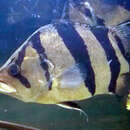mk
имиња во трошки


The Siamese tigerfish (Datnioides pulcher), also known as the Siamese tiger perch, is a critically endangered Asian fish native to the Chao Phraya, Mae Klong and Mekong basins.[1] It has vertical yellow and black stripes running the length of its body. The dorsal fin has a spiny appearance.[2] Siamese tigerfish grow to 40 cm (16 in) in standard length.[3]
The many species within Datnioides are quite commonly confused. Datnioides pulcher is the Siamese tigerfish, or wide-bar datnoid. Datnioides microlepis is the Indonesian tiger datnoid. Datnioides polota is the silver datnoid.
It prefers a pH of 7.6–8.0, and a temperature of 22–26 °C (72–79 °F). The Siamese tigerfish is predatory and will eat smaller fish, various live foods, and frozen foods. Many hobbyists pellet-train their datnoids to reduce the risk of disease and parasites from live food. Captive ones are generally smaller than their wild counterparts, though may still require a large aquarium.[2]
D. pulcher is protected in Thailand, and is on the IUCN Red List as critically endangered.[3]
The Siamese tigerfish (Datnioides pulcher), also known as the Siamese tiger perch, is a critically endangered Asian fish native to the Chao Phraya, Mae Klong and Mekong basins. It has vertical yellow and black stripes running the length of its body. The dorsal fin has a spiny appearance. Siamese tigerfish grow to 40 cm (16 in) in standard length.
The many species within Datnioides are quite commonly confused. Datnioides pulcher is the Siamese tigerfish, or wide-bar datnoid. Datnioides microlepis is the Indonesian tiger datnoid. Datnioides polota is the silver datnoid.
Datnioides pulcher es una especie de pez perteneciente a la familia de los peces tigre.
Estos peces alcanzan los 40 cm. Es un pez de agua dulce, de clima tropical. Espinas dorsales (total): 12; Radios blandos dorsales (total): 16-19; Espinas anales 3; radios blandos anales: 10 - 11. Profundidad del cuerpo 2.1-2.4 veces en SL; barras verticales relativamente estrecho, la primera barra por lo general no continua en el tórax o en la superficie ventral del cuerpo y la segunda barra que se originan en la base del 5 al 6 aleta dorsal columna vertebral, por lo general 11 radios ramificados en la aleta anal.
Asia: Mekong y Chao Phraya.
Datnioides pulcher es una especie de pez perteneciente a la familia de los peces tigre.
Datnioides pulcher Datnioides generoko animalia da. Arrainen barruko Datnioididae familian sailkatzen da.
Datnioides pulcher Datnioides generoko animalia da. Arrainen barruko Datnioididae familian sailkatzen da.
Datnioides pulcher is een straalvinnige vissensoort uit de familie van de zeebladvissen (Datnioididae).[1] De wetenschappelijke naam van de soort is voor het eerst geldig gepubliceerd in 1998 door Kottelat.
Bronnen, noten en/of referentiesCá hổ Thái (Danh pháp khoa học: Datnioides pulcher) là một loài cá nước ngọt trong họ Datnioididae.
Trước đây chúng từng có tên khoa học là Datnioides Microlepis. Sau đó vào năm 1994, ông Kottelat nghiên cứu dựa trên hàng loạt dữ liệu thu thập được các cá thể Datnioides Microlepis ở sông Chao phraya,sông Mekong.b Đến năm 1998, những cá thể Datnioides Microlepis phân bố ở sông Chao Phraza,sông mekong được đổi tên thành Datnioides Pulcher và được công nhận là một loài mới.
Datnioides Pulcher xuất hiện ở lưu vực sông Mekong,Chao Phraya.Nó được cho là tuyệt chủng ở Thái Lan vao những năm 1990.Và hiện tại số lượng Datnoides Pulcher vẫn còn một ít ở Việt Nam,Lào,và Cam-pu-chia nhưng rất hiếm. Số lượng của chúng đã giảm hơn 90% trong vòng 20 năm qua do mức độ khai thác cho thị trường cá cảnh quốc tế. Các nhà máy,xí nghiệp,cơ sở hạ tầng làm ô nhiễm môi trường sống của chúng.
Chúng sở hữu những sọc rất to trên cơ thể,và vảy của chúng thì rất mịn và đôi chỗ ánh kim. Khi chúng trong trạng thái tốt nhất, sọc sẽ đồng nhất 1 khối,đậm và dày. Chúng có thể duy trì trạng thái ổn định này rất lâu. Chúng khá dài,dạng đuôi tách rời, sọc thứ ba có điểm gãy khoảng 1/3,điểm gãy này có rìa vạch nhô ra giống hổ bắc. Dạng đuôi của V của chúng thường là đuôi V nhọn. Đôi khi có những biến thể về gốc đuôi.Sọc giữa của hổ thái xiên nhiều,hội tụ tại 1 điểm,vát về hậu môn, ra hình răng cọp. Cá có sọc không kéo dài lên gai lưng. Sọc của chúng rất dày và đen đậm, chúng có một màu nền vàng chanh,và vảy rất mịn như da gà.
Cá hổ Thái (Danh pháp khoa học: Datnioides pulcher) là một loài cá nước ngọt trong họ Datnioididae.
美拟松鲷(學名:Datnioides pulcher),又可稱日行虎、粗紋三線泰國虎、暹羅虎、柬埔寨虎、粗紋泰國虎,辐鳍魚纲鲈形目鲈亞目擬松鲷科。原產地為湄公河流域、昭披耶河流域。
最大體長可達到40cm,但在水族箱環境內會較小,而野生的個體可長達61cm。
因數量稀少,價格呈倍數成長,達新台幣六位數,尾柄的黑色線條及是否對稱,決定價位的高低,美拟松鲷在泰國已被納入保護與保育,並被列入國際自然保護聯盟瀕危物種紅色名錄極度瀕危物種。